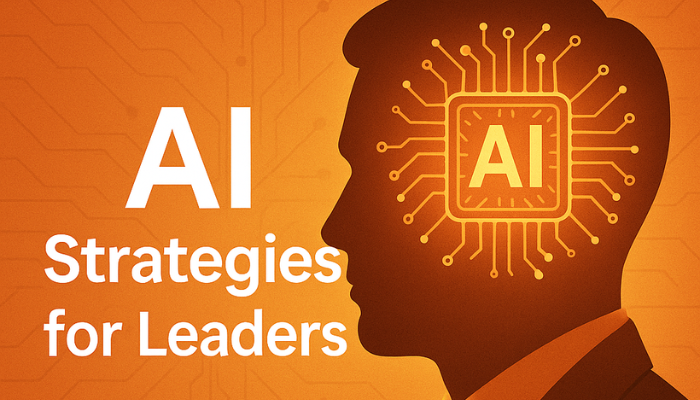You’ve probably seen the headlines: AI is no longer a “future trend.” It’s now a leadership priority. From predictive analytics to generative design, AI is shaping how companies make decisions, serve customers, and scale operations.
But here’s what’s urgent, the global market for AI is expected to hit $990 billion by 2027. That’s not just growth. That’s a shift in how industries will function, how businesses will lead, and how quickly you’ll fall behind if you don’t act.
In 2025, leaders like you won’t just need to know what AI is, but how to think strategically about it. Because smart AI adoption isn’t just about buying tools. It’s about aligning AI with your company’s business model, customers, and culture.
In this blog, we’re walking you through, smarter AI strategies; ones rooted in outcomes, not hype. Ones that fits your business, your team, and your industry. This blog will cover what that strategy looks like, why it matters now more than ever, and how you can lead the change, with real-world examples and insights.
Why Prioritizing AI Strategy is a Must for Today’s Leaders
If you’re still putting off AI decisions, you need to know that the window for experimentation is closing fast. Leadership today isn’t just about adapting to change, it’s about setting direction with clarity and confidence. And AI isn’t something you add later. It has to be part of your business strategy right now.
Reports say, 42% of enterprise-scale companies have actively deployed AI and 59% of companies exploring or deploying AI have accelerated their investments in the technology. This momentum signals one thing: AI isn’t optional, it’s essential for staying competitive.
But even with all this adoption, companies still face some hurdles. The biggest challenges? Lack of AI skills (33%), data complexity (25%), and ethical concerns (23%). But despite these obstacles, the benefits of AI are clear.
When you make AI a priority in your strategy, the advantages are huge:
- Improved Decision-Making: AI enables better, faster decision-making by providing data-driven insights, helping leaders make more informed choices across all areas of their business.
- Enhanced Operational Efficiency: AI streamlines processes, reducing costs and improving productivity. It helps automate routine tasks so your team can focus on higher-value activities.
- Stronger Competitive Advantage: Companies adopting AI are gaining a significant edge over their competitors, enabling them to innovate faster and stay ahead in rapidly changing markets.
- Improved Customer Experience: AI personalizes customer interactions, providing tailored recommendations and support, enhancing satisfaction and loyalty.
- Scalability for Growth: AI solutions are scalable, making it easier for businesses to expand and adjust to increasing demands without compromising quality or performance.
- Data Utilization: By using AI, businesses can extract actionable insights from large volumes of data, turning raw information into a powerful asset for growth.
As the AI market continues to expand, prioritizing AI is no longer just a good idea, it’s a necessity. Leaders who don’t prioritize AI risk being left behind in a rapidly evolving business landscape.
Now that we understand the stakes, let’s explore the core pillars of a winning AI strategy.
6 Must-Have Foundations for Your AI Strategy
You can’t build an AI-driven business on shortcuts. To lead with AI in 2025, you need more than tools, you need strong pillars that support smart decisions, ethical outcomes, and sustainable growth. These are real priorities.
Here’s what that foundation looks like:
a) Executive Ownership of AI Decisions
AI implementation delivers measurable value only when driven by top-level leadership. Assigning senior executives to own AI strategy ensures projects are not fragmented or misaligned with business goals. These leaders must define strategic priorities, enforce governance, and embed accountability frameworks that guide cross-functional adoption. When executive ownership is strong, AI initiatives remain purpose-driven, outcome-focused, and scalable across the organization.
b) Ethical, Transparent, and Safe AI Practices
Building trust in AI systems requires more than technical capability, it demands ethical foresight and transparency. Enterprises must establish structured guidelines to address fairness, bias mitigation, data governance, and model explainability from the ground up. By proactively prioritizing responsible AI practices, companies safeguard brand reputation, ensure regulatory compliance, and deliver technology that is safe, equitable, and sustainable for end users.
c) Strong Data Infrastructure (It’s Non-Negotiable)
Without a clean, connected, and accessible data ecosystem, even the most advanced AI models will underperform or fail entirely. Organizations must prioritize building a robust data infrastructure that integrates disparate sources, maintains data quality, and supports real-time access. A well-structured data foundation empowers AI systems to deliver accurate insights, operate at scale, and drive measurable business outcomes across all departments.
d) Upskilled Teams and an AI-Ready Culture
Successful AI adoption is not just about tools, it requires a fundamental shift in mindset and capability across the organization. Teams must be upskilled to understand how AI technologies function, where they add value, and how to collaborate with them effectively. This involves continuous training, cross-departmental learning, and fostering a culture where employees view AI as a partner in productivity, rather than a threat to job security.
e) Collaboration Across Business and Tech
Artificial Intelligence initiatives fail when developed in isolation; meaningful success comes only when marketing, product, compliance, engineering, and leadership collaborate from the start. Building AI systems that are adopted and scaled across the enterprise requires input from every function, ensuring relevance, compliance, usability, and real-world value. Without this cross-functional alignment, even well-funded pilots tend to stall without ever reaching production.
f) Build Fast, Learn Faster: Stay Agile
AI strategies must remain fluid and iterative, not locked into rigid, multi-year plans that can’t adapt to changing conditions. The most successful organizations embrace agility by working in short development cycles; rapidly prototyping, testing with real users, gathering feedback, and refining continuously. Gartner refers to this as the “composable enterprise” model, where modular, adaptable systems help teams stay ahead of evolving business needs and technological shifts.
Let’s break down how you can roll out your AI strategy without overwhelming your teams.
Implementing AI Strategy: A Phased Approach for Leaders
AI success is not driven by bold claims or futuristic promises, it is built through smart, deliberate execution rooted in business context. As a leader, having a strong vision is just the starting point; what you truly need is a structured, actionable roadmap that turns that vision into tangible, long-term value.
This phased playbook walks you through how to actually make AI happen in your organization; step-by-step, starting from the ground up. Let’s get into the real, practical phases of implementing an AI strategy that delivers outcomes.
Phase 1: Get Your Organization AI-Ready
Before initiating any AI initiative, leaders must ensure that the organization is fully prepared to support it. This involves more than just adopting the latest tools, it requires building a strong foundation across strategy, systems, and teams to enable long-term success.
Actionable Steps:
a) Align AI with Business Objectives
Start by identifying clear, measurable business outcomes that AI is expected to drive. Ask yourself, “What specific process or challenge do we want AI to improve?” Whether the goal is to optimize your logistics pipeline, enhance customer interactions, or predict equipment failures, tying AI to real business objectives ensures stakeholder buy-in and focused execution from the outset.
b) Evaluate Data Quality
Conduct a thorough audit of your existing data to assess its readiness for AI use. Examine whether the data is complete, consistent, and well-structured, and identify any gaps that need to be addressed. AI performance is only as good as the data it trains on, so partnering with experienced data engineers or data scientists at this stage can help you build a reliable foundation and avoid critical errors down the line.
Your AI’s only as good as its homework, has it passed the audit? Get a full AI-readiness check with Codewave’s AI Audit before you scale anything.
c) Assess IT Infrastructure
Evaluate the current state of your organization’s IT infrastructure to determine if it can support AI workloads efficiently. Consider factors like processing power, storage capacity, and system interoperability. If your existing setup falls short, prioritize investments in scalable cloud platforms, edge computing capabilities, or upgrading on-premise servers.
Tip: Collaborate closely with IT leaders to design a future-ready architecture that ensures secure and seamless AI integration across departments.
d) Talent and Skills Audit
Assess your current talent pool to identify whether you have the right mix of AI-focused skills like machine learning, data science, or data engineering. If gaps exist, create a roadmap to upskill existing staff or onboard new talent with AI expertise.
Action: Host internal bootcamps or partner with external learning platforms to run structured AI training programs that build technical and strategic readiness across teams.
By ensuring readiness, you’ll be laying a solid foundation that minimizes risks down the road.
Phase 2: Consider Quick Wins
It’s time to shift from strategy to execution. To build momentum and generate excitement, begin with small, manageable initiatives that showcase AI’s real-world value. These quick wins not only deliver early results but also boost team confidence and help secure stakeholder buy-in for larger initiatives down the road.
Actionable Steps:
a) Identify Low-Hanging Fruit
Focus on selecting projects that are simple to implement yet impactful enough to demonstrate clear value. For instance, if your customer service team is overwhelmed, deploying an AI-powered chatbot to handle frequent inquiries can free up human resources for more complex tasks.
Tip: Target repetitive, time-consuming tasks that offer immediate efficiency gains when automated through AI.
b) Measure Early Results
Establish clear and measurable KPIs from the start, such as reduction in response time, operational cost savings, or improvements in customer satisfaction. Begin tracking performance from day one to validate the ROI of your AI investments.
Action: Develop a centralized dashboard that enables you to visualize performance data, communicate outcomes, and highlight quick wins across teams.
c) Build Trust Through Transparency
To foster organization-wide support, keep employees informed about how AI is being used and the value it’s delivering. Transparency builds trust and eases concerns around change.
Tip: Distribute weekly updates that highlight AI-driven outcomes and recognize team contributions, reinforcing a culture of learning and progress.
This phase is about proving that AI can make things better now, not just in the future.
Phase 3: Build Skills and Integrate AI
Successful AI adoption requires more than technology—it demands a coordinated effort across people and systems. For AI to truly transform your organization, your workforce needs to understand its impact, and your operational processes must fully integrate AI capabilities.
Actionable Steps:
a) Invest in AI Literacy Across Departments
AI is not exclusively the domain of your technical teams. Every employee, regardless of their role, should have at least a foundational understanding of how AI affects their daily work and contributes to business goals.
Action: Create a company-wide training program with courses that break down the basics of AI for non-technical teams (sales, HR, marketing).
b) Embed AI in Business Units
In this phase, the objective is to weave AI into your core business functions, making it a natural part of daily operations. Begin applying AI tools to enhance processes within marketing, sales, and HR. For example, use AI-driven customer segmentation to create highly targeted and personalized marketing campaigns, improving conversion rates and customer engagement.
c) Create a Data Governance Framework
A critical aspect of AI integration is establishing clear policies on data management, including collection, storage, and protection. Implement regular data audits to maintain compliance with privacy regulations and industry standards.
Tip: If you haven’t already, appoint a dedicated data governance officer to oversee data integrity and regulatory compliance.
d) Foster Collaboration Across Teams
To maximize AI’s impact, encourage cross-functional collaboration by forming an AI task force that includes members from IT, operations, and business units.
Tip: Organize bi-weekly meetings to review AI projects, share insights, and coordinate efforts across departments.
With the right talent and collaboration in place, you’ll be in a strong position to move to the next phase.
Phase 4: Scale AI Across Operations
By now, you should have a clear AI use case, so it’s time to take the lessons learned from early projects and scale them across core operations.
Actionable Steps:
a) Scale AI Solutions Across Key Operations
Begin by extending AI applications into higher-value areas that can deliver significant returns. For instance, in manufacturing, predictive maintenance can reduce downtime, while dynamic pricing models can optimize revenue in retail environments.
Tip: Start by assessing which critical business functions; such as supply chain management, finance, or human resources, stand to benefit most from AI-driven improvements.
b) Integrate AI into Existing Tools
Rather than developing new systems from scratch, focus on embedding AI capabilities within your current technology stack. Integrate AI models into existing CRM, ERP, and business intelligence platforms to enhance data-driven decision-making and streamline workflows.
Tip: Collaborate closely with your IT department to ensure seamless integration of AI functionalities into your established software tools.
Also read: 15 AI Tools for Ecommerce Growth
c) Build Cross-Functional Teams for AI
Successful scaling requires cooperation between diverse teams. For example, IT professionals need to work alongside sales and marketing teams to deploy AI-driven sales forecasting models effectively. Cross-functional collaboration ensures broader adoption and better alignment with business goals.
d) Optimize Key Processes
Focus on automating more complex tasks, like demand forecasting, fraud detection, or personalizing the customer experience.
Tip: Use AI to predict trends and make proactive adjustments to your strategy.
Scaling AI in core areas will increase efficiency, and more importantly, prove its business impact.
Phase 5: Use AI to Innovate and Lead
Now that you have AI running smoothly, it’s time to push boundaries and reimagine your business model.
Actionable Steps:
a) Create AI-First Products or Services
Consider developing products or services where AI is not just an add-on but central to the value proposition. For example, healthcare companies might launch AI-driven diagnostic tools that improve accuracy and speed of patient care.
Action: Organize brainstorming sessions with your product development team to identify promising AI opportunities and potential applications.
b) Experiment with New Revenue Models
AI opens the door to innovative revenue streams, such as dynamic pricing strategies or AI-powered subscription services that adapt to customer needs in real time.
Tip: Test these new revenue models through limited pilot launches before scaling them across the business.
c) Drive Industry Innovation
Position your organization as an industry leader by using AI to disrupt traditional practices and set new trends. Consider launching AI-driven platforms that fundamentally change how customers engage with your services.
Tip: Continuously analyze industry developments to uncover opportunities for AI-driven transformation.
At this stage, your organization can start leading the market, using AI as a transformative force.
Phase 6: Monitor, Improve, and Stay Ahead
AI is not a set-and-forget solution; to ensure long-term success, continuous evolution and close monitoring of its impact are essential. Organizations must proactively manage their AI systems to adapt to changing conditions and emerging challenges.
Actionable Steps:
a) Create an AI Governance Framework
Regularly audit AI systems to ensure compliance with ethical standards. You’ll need to monitor how well AI systems are performing and identify any biases or issues early on.
Action: Set up regular reviews and updates for your AI governance team to ensure that it remains aligned with ethical guidelines.
b) Iterate and Retrain Models
Given that AI systems rely on data, they require ongoing refinement. Tracking their effectiveness and retraining models with new data is necessary to maintain accuracy and relevance.
Tip: Implement continuous feedback loops to facilitate constant model improvement and adaptation to new insights.
c) Promote Continuous AI Education
Keeping your team updated on the latest AI advancements is critical to maintaining a competitive edge. Falling behind on trends and technologies can compromise your AI initiatives.
Action: Organize quarterly AI learning sessions and invite industry experts to provide insights on emerging developments.
Sustainability isn’t about maintaining the status quo, it’s about staying ahead of the curve.
As you move forward, addressing challenges in AI implementation is key to sustainable success.
Challenges in AI Strategy Implementation
AI strategy isn’t without its hurdles. As a leader, knowing how to identify and overcome these challenges will determine your AI success. Let’s dive into the top obstacles you may face and how to address them.
1. Lack of Skilled Talent
The Challenge: AI requires specialized skills that many companies struggle to find. Whether it’s data scientists or AI engineers, a shortage of talent can delay or halt progress.
How to Solve: Invest in upskilling existing teams through training programs, partnerships with universities, or using AI platforms that simplify implementation. Also, consider leveraging AI consultancy to get started while building internal capabilities.
2. Poor Data Quality
The Challenge: AI models are only as good as the data fed into them. Inconsistent, outdated, or incomplete data can lead to inaccurate insights and missed opportunities.
How to Solve: Ensure your data is clean, connected, and standardized across departments. Use data management tools to automate cleaning processes and invest in regular data audits to maintain quality.
3. Resistance to Change
The Challenge: Employees may fear AI replacing their jobs or resist shifting to new workflows, creating internal friction.
How to Solve: Communicate the value AI brings, not as a replacement, but as a tool to enhance work. Offer support through training and foster a culture of collaboration between AI and human workers.
4. Integration with Legacy Systems
The Challenge: Many businesses rely on outdated IT infrastructure, making it difficult for AI tools to integrate seamlessly.
How to Solve: Begin with small, non-intrusive AI applications that can coexist with existing systems. Gradually modernize your IT architecture while ensuring any new AI initiatives are designed with compatibility in mind.
5. Ethical Concerns and Bias
The Challenge: AI models can unintentionally perpetuate biases or make unethical decisions, raising concerns over fairness, transparency, and accountability.
How to Solve: Implement strict ethical guidelines for AI use, such as fairness, transparency, and bias detection. Regularly audit AI algorithms for bias and engage with diverse teams to ensure ethical decision-making.
How Codewave Helps Leaders Build Smarter AI Strategies
Leaders need more than tools—they need innovation partners. That’s where Codewave, a design-thinking-led digital innovation company, steps in. Founded in 2013, we have helped B2B organizations across HealthTech, BFSI, RetailTech, and TravelTech embrace AI transformation with measurable outcomes.
Leaders working on AI strategies can use Codewave’s strengths in:
- AI/ML Development & GenAI: We build customized, production-ready AI models that align with your business KPIs, ensuring outcomes are measurable and impactful.
- Data Analytics & Python Development: Our experts clean, analyze, and activate data to provide the insights you need for strategic decision-making and forecasting.
- Custom Software + Cloud Infrastructure: We design scalable and secure solutions to support your AI initiatives, ensuring future-ready deployments.
- UX/UI & Customer Experience Design: Codewave focuses on human-centric AI adoption, ensuring your AI interfaces are intuitive, accessible, and add real value for end-users.
- Blockchain, IoT, XR, and Automation: We integrate advanced technologies to enhance system efficiency, transparency, and operational flow.
We believe that digital transformation isn’t just code, it’s culture. We work with leaders to make AI strategy part of that culture. Want to align your AI vision with execution?
Talk to Codewave’s Innovation Team Today!
End Note
A smart, structured AI strategy can help leaders navigate uncertainty, unlock new value, and drive meaningful transformation across their organizations. But it’s not just about adopting AI, it’s about making it part of your leadership DNA.
Now’s the time to move from thinking to doing. Start small, scale smart, and build systems that learn with you. AI success comes from alignment, between people, tech, and vision.
At Codewave, we help leaders design and implement AI strategies that are not only technically sound but culturally aligned and future-focused. If you’re ready to lead with AI instead of reacting to it, we’re ready to partner with you.
Contact our Innovation Team today and let’s shape your AI-led future together.
Also read: Top AI Frameworks and Libraries to Learn
Codewave is a UX first design thinking & digital transformation services company, designing & engineering innovative mobile apps, cloud, & edge solutions.







